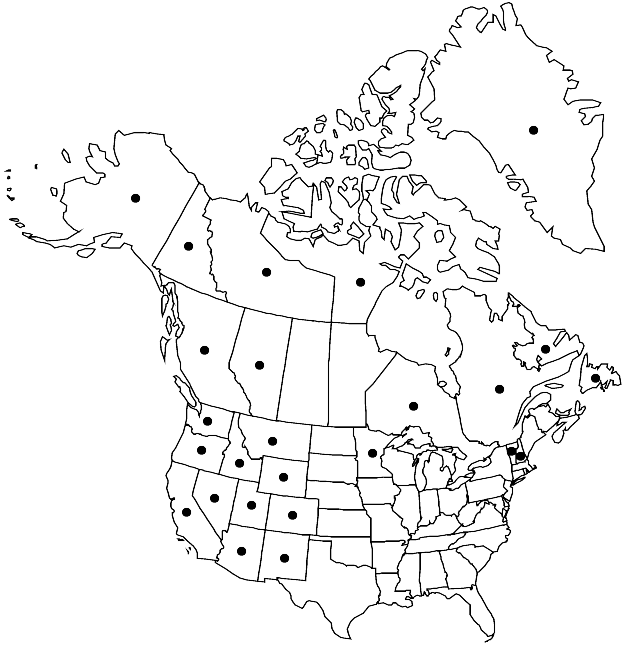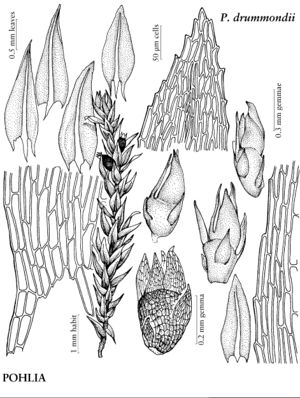Pohlia drummondii
in A. J. Grout, Moss Fl. N. Amer. 2: 196. 1935.
Plants medium-sized, dark green to reddish, glossy. Stems 0.5–3.5 cm. Leaves ± spreading, unaltered when dry, lanceolate to ovate-lanceolate, 0.9–1.5 mm; margins serrulate to serrate in distal 1/3; costa subpercurrent; distal medial laminal cells rhombic to rhomboidal, 50–95 µm, walls thin. Specialized asexual reproduction usually present when sterile; axillary gemmae single, bulbiform, cherry red, ± black when dry, leaf primordia at gemma apex and below, laminate, large, flexuose. Sexual condition dioicous; perigonial leaves ovate; perichaetial leaves scarcely differentiated, ovate-lanceolate. Seta orange-brown. Capsule inclined 95–180°, brown to stramineous, pyriform, neck 1/3 urn length; exothecial cells short-rectangular, walls sinuate; stomata superficial; annulus present; operculum convex-conic; exostome teeth yellow-brown, narrowly triangular-acute; endostome hyaline, basal membrane 1/2 exostome length, segments distinctly keeled, broadly perforate, cilia short to rudimentary. Spores 16–21 µm, finely roughened.
Phenology: Capsules mature summer (Jun–Aug).
Habitat: Acid, relatively humus-rich soil, alpine tundra, stream banks, path banks
Elevation: low to high elevations
Distribution

Greenland, Alta., B.C., Nfld. and Labr., N.W.T., Nunavut, Ont., Que., Yukon, Alaska, Ariz., Calif., Colo., Idaho, Minn., Mont., Nev., N.H., N.Mex., Oreg., Utah, Vt., Wash., Wyo., Europe.
Discussion
Pohlia drummondii has red stems (when moist) with cherry red (when fresh) bulbiform gemmae in the leaf axils. The gemmae look like small branches, with flexuose, laminate leaf primordia, and occur singly or occasionally in pairs in one to five distal leaf axils. The leaves of P. drummondii are carinate and can be similar to those of P. obtusifolia, but are not cucullate, and the plants are dioicous.
Selected References
None.
